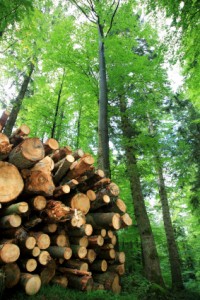Article by Sandy Gray, CEO of American Hardwood Co., Garden, California
 As CEO of a leading wood blind and shutter components manufacturing company, I am frequently asked if we are running out of wood. I am always pleased and proud to answer this question because in contrast to what is portrayed in the mass media, we in America’s wood products industries have a very good story to tell. It is important for everyone to know the facts so we can wisely use wood, our most abundant renewable resource.
As CEO of a leading wood blind and shutter components manufacturing company, I am frequently asked if we are running out of wood. I am always pleased and proud to answer this question because in contrast to what is portrayed in the mass media, we in America’s wood products industries have a very good story to tell. It is important for everyone to know the facts so we can wisely use wood, our most abundant renewable resource.
The truth is that America’s forests in many ways are in better shape today than they have been at any time this century. Often when the word “wood” is mentioned, immediate concern is raised that our forests are disappearing. Much of this concern is a result of widespread reporting on the significant deforestation of tropical rain forests and the resulting implications for the entire planet. It is, however, a mistake to apply this fear to our North American forests. Following are some U.S. forest facts:
- Net forest growth today in the United States exceeds harvest by 37 percent.
- In the United States, a combination of improved forest management, increased fire protection and advances in wood use has allowed for forest growth to surpass removals, even as harvest volume has increased.
- The forests of the United States now contain 170 million cubic feet more volume than they did just 40 years ago. The increase is equal to 10 years of average annual use.
- Hardwood net growing in the United States increased 82 percent between 1952 and 1992.
Eco-Friendly
The vast majority of wood used for wood window blinds and shutters is basswood and poplar, both domestic hardwood species. The reasons for their dominance in the wood window coverings industry are their stability and lightweight. To a lesser degree, other domestic species, such as cedar, aspen and cottonwood are used. Additionally, ramin, a tropical rain forest specie, is being imported from Indonesia.
The statistics for average annual growth and removal of basswood and poplar in the U.S. forests tell a good story indeed. It is fair to say that poplar is growing more than twice as fast as it is being cut and basswood is growing more than three times as fast as it is being harvested!
Recently, window coverings products made from various forms of plastics have been marketed and environmentally sensitive alternatives to wood slats and louvers. While plastic alternatives have a place in the window coverings industry (in high moisture environments and as low cost alternatives), marketing them as environmentally friendly is misleading.
To begin with, besides cotton, wood is the only renewable resource used in the window coverings industry. Plastics and synthetic fibers are all petroleum based and aluminum is mined from fixed reserves in the ground. Once all the petroleum and minerals for aluminum are used up, there won’t be any more. Contrast this scenario with wood – not only is their more wood fiber growing every day, there’s more growing even after subtracting the amount harvested!
Additionally, the production of wood is far more energy efficient that the production of any other raw material resource. Although wood accounts for 17 percent of all primary industrial raw material consumed in the United States. Solid wood manufacturing processes for lumber and plywood consume only four percent of all energy consumed in the manufacture of primary raw materials.
The greater energy efficiency of the production of wood means less carbon dioxide emissions (the primary gas contributing to the “greenhouse effect”) into the global atmosphere.
In summary, not only does wood uniquely bring natural warmth and charismatic beauty to all interiors, it is the most environmentally beneficial material for use in window coverings. Rather than promoting the use of non-renewable wood substitutes, our industry should be looking for more ways to use wood, the extraordinary resource that is renewable, recyclable and biodegradable.